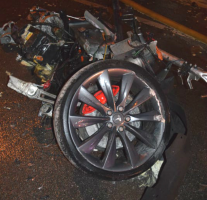— An Indianapolis Tesla Model S crash is at the heart of a lawsuit that alleges multiple defects killed the passenger who was also the lessee of the car.
The lawsuit was filed by the wife of Kevin McCarthy, 44, the lessee of the 2015 Model S that crashed November 3, 2016, at about 1 a.m. on Illinois Street. The car was driven by Casey Speckman, 27, who was also killed in the crash.
According to the lawsuit, McCarthy and Speckman worked together and were entertaining clients at a hotel in downtown Indianapolis, Indiana, when they left the hotel and walked to the Model S.
Speckman allegedly lost control of the car due to an "uncommanded acceleration defect" that occurred while trying to avoid an oncoming vehicle driving the wrong way on the one-way street.
The Model S went off the right side of the road, hit a curb and slammed into a tree, finally coming to rest against a wall.
The lawsuit claims McCarthy was seen alive trying to escape the car which had exploded into flames. But lawyers for the plaintiff claim he couldn't escape because of defects in the Model S, "causing him to suffer thermal injuries and exposure to toxic gases." According to the lawsuit, McCarthy died at 1:37 a.m. from injuries he suffered in the fire.
The event data recorder, or so-called black box, allegedly says the Model S accelerated from 10 mph to 70 mph in the five seconds before the car hit the curb. The data recorder says the driver pressed the accelerator pedal and didn't apply the brake pedal in the five seconds before the car hit the curb, but lawyers for the plaintiff say there is no proof the data is accurate.
The recorder shows the frontal airbags deployed 0.8 seconds after the car hit the curb, but the recorder's memory chip allegedly contains data only for the first frontal impact with the curb.
In addition to an alleged defect that caused uncommanded acceleration, the lawsuit says the lack of an effective automatic emergency braking system caused the crash. Lawyers for the plaintiff claim Tesla knew prior to the crash an automatic emergency braking system would avoid or reduce the severity of a crash.
Named in the lawsuit as another defect is the 1,200-pound lithium-ion battery which contains more than 7,000 battery cells at risk of fires that can be extremely difficult to extinguish.
Lawyers for the plaintiff also claim the door handles on the Model S were defective and led to "entrapment by occupants, preventing passengers from being able to escape from the interior while at the same time hampering the efforts of others outside the vehicle to be able to free them."
According to the lawsuit, Tesla deliberately didn't fix the alleged defects and didn't inform Mr. McCarthy about the "extreme risk of injury."
"Defendants’ conduct was despicable, and so contemptible that it would be looked down upon and despised by ordinary decent people and was carried on by Defendants with a willful and conscious disregard for the safety of Plaintiffs and others, entitling Plaintiffs to exemplary damages under Civil Code section 3294."
Tesla said in 2017 the damage and debris field indicated a collision that occurred at very high speed, matching an eyewitness report to a TV reporter shortly after the crash. The witness said the Model S was traveling erratically at a high rate of speed seconds before the crash.
Indiana's legal alcohol limit is 0.08 percent, but police investigators reported that Speckman, who was driving the car, had a blood-alcohol level of 0.21 percent, a level that can easily cause a person to blackout. Mr. McCarthy's blood-alcohol level tested at 0.17 percent.
The Tesla Model S lawsuit was filed in the Superior Court of California, County of Alameda - Stacey McCarthy v. Tesla, Inc, et al.
The plaintiff is represented by Arias, Sanguinetti, Wang & Torrijos, and the Slavik Law Firm.

